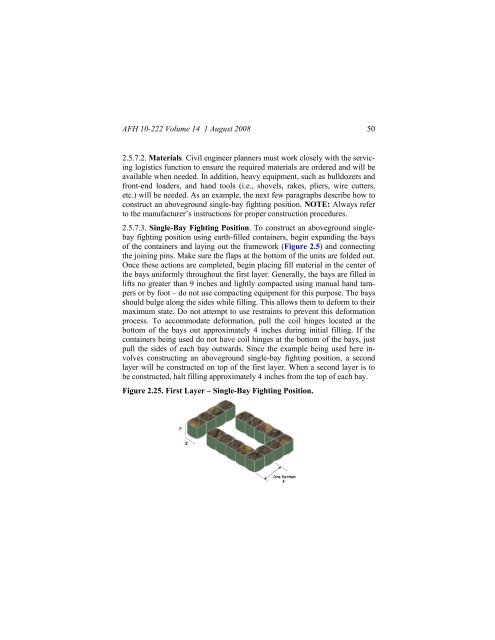Civil engineer guide to fighting positions, shelters, obstacles
Civil engineer guide to fighting positions, shelters, obstacles
Civil engineer guide to fighting positions, shelters, obstacles
Create successful ePaper yourself
Turn your PDF publications into a flip-book with our unique Google optimized e-Paper software.
AFH 10-222 Volume 14 1 August 2008 50<br />
2.5.7.2. Materials. <strong>Civil</strong> <strong>engineer</strong> planners must work closely with the servicing<br />
logistics function <strong>to</strong> ensure the required materials are ordered and will be<br />
available when needed. In addition, heavy equipment, such as bulldozers and<br />
front-end loaders, and hand <strong>to</strong>ols (i.e., shovels, rakes, pliers, wire cutters,<br />
etc.) will be needed. As an example, the next few paragraphs describe how <strong>to</strong><br />
construct an aboveground single-bay <strong>fighting</strong> position. NOTE: Always refer<br />
<strong>to</strong> the manufacturer’s instructions for proper construction procedures.<br />
2.5.7.3. Single-Bay Fighting Position. To construct an aboveground singlebay<br />
<strong>fighting</strong> position using earth-filled containers, begin expanding the bays<br />
of the containers and laying out the framework (Figure 2.5) and connecting<br />
the joining pins. Make sure the flaps at the bot<strong>to</strong>m of the units are folded out.<br />
Once these actions are completed, begin placing fill material in the center of<br />
the bays uniformly throughout the first layer. Generally, the bays are filled in<br />
lifts no greater than 9 inches and lightly compacted using manual hand tampers<br />
or by foot – do not use compacting equipment for this purpose. The bays<br />
should bulge along the sides while filling. This allows them <strong>to</strong> deform <strong>to</strong> their<br />
maximum state. Do not attempt <strong>to</strong> use restraints <strong>to</strong> prevent this deformation<br />
process. To accommodate deformation, pull the coil hinges located at the<br />
bot<strong>to</strong>m of the bays out approximately 4 inches during initial filling. If the<br />
containers being used do not have coil hinges at the bot<strong>to</strong>m of the bays, just<br />
pull the sides of each bay outwards. Since the example being used here involves<br />
constructing an aboveground single-bay <strong>fighting</strong> position, a second<br />
layer will be constructed on <strong>to</strong>p of the first layer. When a second layer is <strong>to</strong><br />
be constructed, halt filling approximately 4 inches from the <strong>to</strong>p of each bay.<br />
Figure 2.25. First Layer – Single-Bay Fighting Position.
















